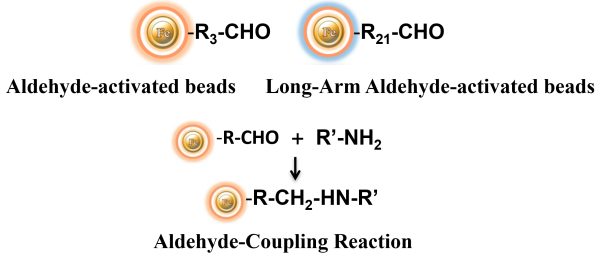- +1 858 909 0079
- +1 858 909 0057
- [email protected]
- +1 858 909 0079
- [email protected]

Products
Cat. No.
Product Name
Unit Size
Order
FE109
BcMag™ Aldehyde-Activated Magnetic Beads Conjugation Buffer Kit
Kit Components
– Conjugation Buffer: 100 ml (0.1 M sodium phosphate, pH 7.0)
– Blocking Buffer: 25 ml (1 M Tris•HCl, pH 7.4)
– 10x Wash Buffer: 25 ml (1 M NaCl)
– Coupling Reagent: 0.5 ml [5M NaCNBH3 (Dissolve in 1 M NaOH)]
Each
Specification
Composition
Magnetic beads are grafted with a high density of aldehyde groups on the surface
Number of Beads
~ 1.68 x 109 beads/mg (1μm beads)
~ 5 x 107 beads /mg (5μm beads)
Stability
Short Term (<1 hour): pH 3-11; Long-Term: pH 4-10
Temperature: 4°C -140°C; Most organic solvents
Magnetization
~40-45 EMU/g
Type of Magnetization
Superparamagnetic
Formulation
Lyophilized Powder
Functional Group Density
1μm Magnetic Beads
~260 μmole / g of Beads
5μm Magnetic Beads
~200 μmole / g of Beads
1μm Long-Arm Magnetic Beads
~210 μmole / g of Beads
5μm Long-Arm Magnetic Beads
~160 μmole / g of Beads
Storage
Ship at room temperature. Store at -20°C upon receipt.
BcMag™ Aldehyde-Activated Magnetic Beads are uniform, silica-based superparamagnetic beads grafted with a high density of aldehyde functional groups on the surface. The bead aldehyde groups react spontaneously with primary amines present at the N-terminus of proteins or in lysine residues to form intermediate Schiff Base complexes. The reaction of reductive amination immobilization starts with the creation of an initial Schiff base between the aldehyde and amine groups, which is then reduced to a secondary amine by the addition of sodium cyanoborohydride (NaCNBH3) to generate stable amine bonds between the Bead and the ligand. At physiological to alkaline circumstances (pH 7.2 to 9) in either aqueous or organic solvents with 20- 30% DMSO or DMF, coupling reaction takes 2 to 6 hours in a one-step process. Coupling efficiency with antibodies and normal proteins is usually better than 85%, resulting in 15 – 20 μg /mg of beads.

The Aldehyde-Activated resins have higher coupling efficiency than cyanogen bromide (CNBr) activated supports. Furthermore, the aldehyde Chemistry generates an uncharged connection with the amine-containing ligand that is more stable than the CNBr approach. The hydrophilic surface ensures excellent dispersion and easy handling in various buffers. When utilized for affinity purification methods, these features allow better leak-resistant immobilization and lower nonspecific binding. BcMag™ Aldehyde-Activated Magnetic Beads are suitable for conjugating a large protein. At the same time, BcMag™ Long-arm Aldehyde-Activated Magnetic Beads are ideal for conjugating small peptides because the long-arm hydrophilic linker may reduce steric hindrance.
BcMag™ Aldehyde-Activate Magnetic Beads work perfectly as solid resin for various affinity purifications to refine molecules, cells, and parts of cells into purified fractions. After conjugation with ligands, add the beads to a solution containing the target molecules, then mix, incubate, wash and elute the target molecules

●
Quick, Easy, and one-step high-throughput procedure; eliminates columns or filters or a laborious repeat of pipetting or centrifugation
●
Stable covalent bond with minimal ligand leakage
●
High capacity – Immobilize 15 -20 μg antibody/mg beads
●
Scalable – easily adjusts for sample size and automation
●
Low nonspecific binding
●
Reproducible results
●
Application: Purification for antibody, protein/peptide, DNA/RNA, cell sorting, immunoprecipitation
Magnetic Beads Make Things Simple